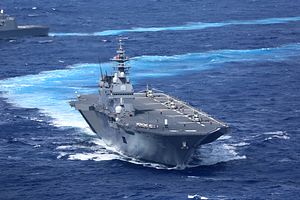A study commissioned by Japan’s Ministry of Defense (MoD) and conducted by Japanese shipbuilder Marine United Corporation (MUC) has concluded that the company’s helicopter destroyer JS Izumo, the lead ship of the Izumo-class, along with its sister ship, JS Kaga, can be turned into fully fledged aircraft carriers in case Japan is required to support U.S. military operations.
The study, which was released in redacted form by the MoD on April 27, asserts that the Izumo-class with certain modifications can operate the F-35B–the U.S. Marine Corps variant of F-35 Joint Strike Fighter capable of vertical or short takeoffs and vertical landings (STOVL) without requiring a catapult launcher—from the warship’s flight deck.
The report was specifically prepared in order to assess how the Izumo-class could be used to provide rear-line support to the U.S. military during joint military operations including U.S.-Japanese naval exercises. For example, following the retrofit, the carrier could be used as a landing platform for U.S. F-35Bs experiencing mechanical problems. (The U.S. Marine Corps is operating a squadron of 16 F-35Bs at Iwakuni airbase in Yamaguchi Prefecture, Japan.)
MUC was also asked to provide an estimate for total cost of the conversion to a full-fledged carrier and a construction schedule along with details of the modifications necessary to operate F-35Bs. Many of these details, however, were redacted from the publicly available version. Yet as I noted in February 2018, according to a Japan Maritime Self Defense Force (JMSDF) source, the Izumo-class has purportedly been designed to operate STOVL fighter jets all along and would only require minor modifications to accommodate the F-35B:
[A] consensus was privately reached at the inception of the Izumo project that the warships should be designed allowing for a future conversion into a F-35B-carrying naval platform. (…)
Modifications on the Izumo-class, among other things, would require the installation of a ski-jump. Contrary to earlier reports, the JMSDF executive claims that the flight deck has already been coated with paint that can withstand the exhaust heat generated during F-35B landings and takeoffs. Additionally, the aircraft elevators, connecting the flight deck with the hangar, were reportedly specifically designed to accommodate the F-35B.
The report confines its analysis to the potential use of the flattop by U.S. military fighter jets and does not address the possibility of operating Japan Self Defense Force STOVL aircraft. Indeed, the MoD has repeatedly denied any intention to convert the Izumo-class—designated by the JMSDF as helicopter destroyers to downplay the ships’ offensive warfighting capabilities. Nonetheless, Japan’s MoD has privately expressed an interest in procuring the F-35B for service on Japanese-held islands skirting the East China Sea. These aircraft could also operate from the Izumo’s flight deck. Up until now, the MoD has refused to comment on the potential acquisition publicly.
It is worth pointing out that should the Izumo-class indeed undergo modifications to accommodate the F-35B, the warships’ anti-submarine warfare capabilities (ASW) would probably be reduced as the ship would no longer be capable of carrying its full contingent of Mitsubishi-built SH-60k ASW helicopters.






























